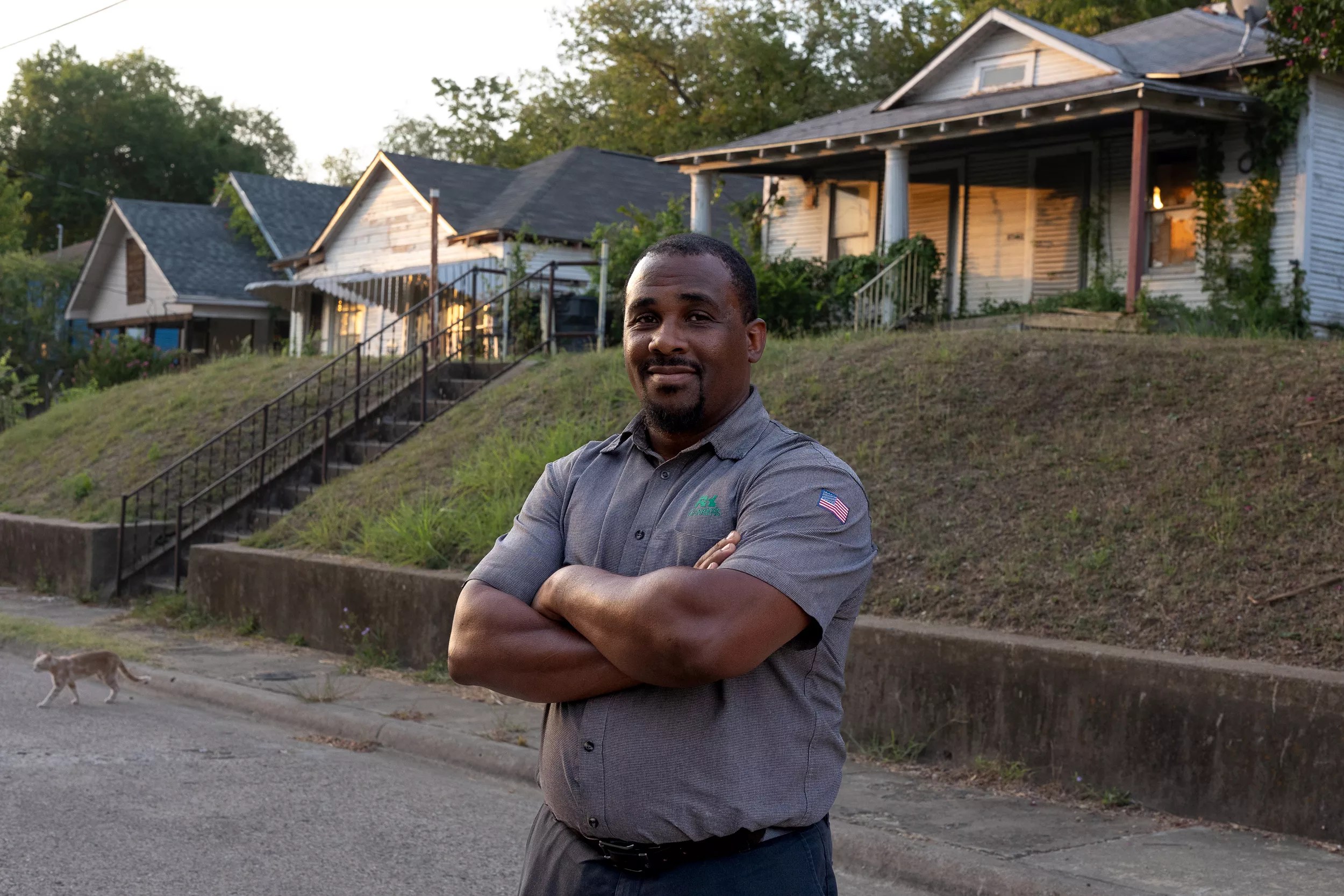
Nathan Hunsinger

Audio By Carbonatix
One day in 2016 Larry Johnson and his son were driving through an Oak Cliff neighborhood when they saw an older couple cutting their grass. “It was a hot day, and I told my son they’re going to die,” Johnson recalled.
He stopped to talk to the couple and returned the next week to cut the grass. That’s when he met Patricia Cox and Shaun Montgomery, two long-time residents of the neighborhood.
They pulled up in their car, introduced themselves and asked Johnson if he owned the lot. He told them no but that he was interested in buying a home in the neighborhood. “They were excited,” he said.
Cox asked Johnson, “Do you know where you are?”
This year, make your gift count –
Invest in local news that matters.
Our work is funded by readers like you who make voluntary gifts because they value our work and want to see it continue. Make a contribution today to help us reach our $30,000 goal!
Johnson responded, “Yes, I’m in northeast Oak Cliff.”
“But do you know where you are?” Cox replied.
“I thought to myself, this crazy old lady, I think she’s lost it,” Johnson recalled. He said again that he understood he was in northeast Oak Cliff.
Cox asked a third time. Finally, Johnson said, “Where am I?”
“Son, you’re in Tenth Street,” Cox said.
Until then, he didn’t know what Tenth Street or a freedmen’s town was. She explained, “This is where we settled after we were freed.”
Freedmen’s (also called freedmans or freedman’s) towns are communities set up by emancipated Black people after the Civil War. Tenth Street is often regarded as one of the most intact freedmen’s towns in the country.
“It was pretty sobering,” Johnson said. “I actually wanted to take off my shoes. I felt like I was on holy ground. To this day, I’m a student of Tenth Street.”
Soon, he started attending community meetings about the neighborhood “and before you knew it, I was all in,” he said.
Johnson is now a member of the Tenth Street Residential Association and the neighborhood’s taskforce for Dallas’ Landmark Commission. He’s also a part-time resident of the neighborhood. He’s fixing up a house in the area and living in another part of Oak Cliff until his home in Tenth Street is finished.
Since Johnson became involved, he’s heard about the issues that have long plagued the community, such as underinvestment, gentrification and blight. The neighborhood is facing similar challenges today, he said.
“This is where we settled after we were freed.” – Patricia Cox, Tenth Street resident
As some lots sit vacant and some structures fall apart, much is happening around Tenth Street. There’s a new deck park in the works to the southwest, and Bishop Arts District appears to be expanding. Residents in Tenth Street are left to wonder about their place in all this new development.
Residents and advocacy groups have been working for years to preserve Tenth Street. The historic designation the town received in 1993 offers certain protections, such as limiting what can be built in Tenth Street. Even so, the designation hasn’t stopped the neighborhood from needing to fight to stay alive.
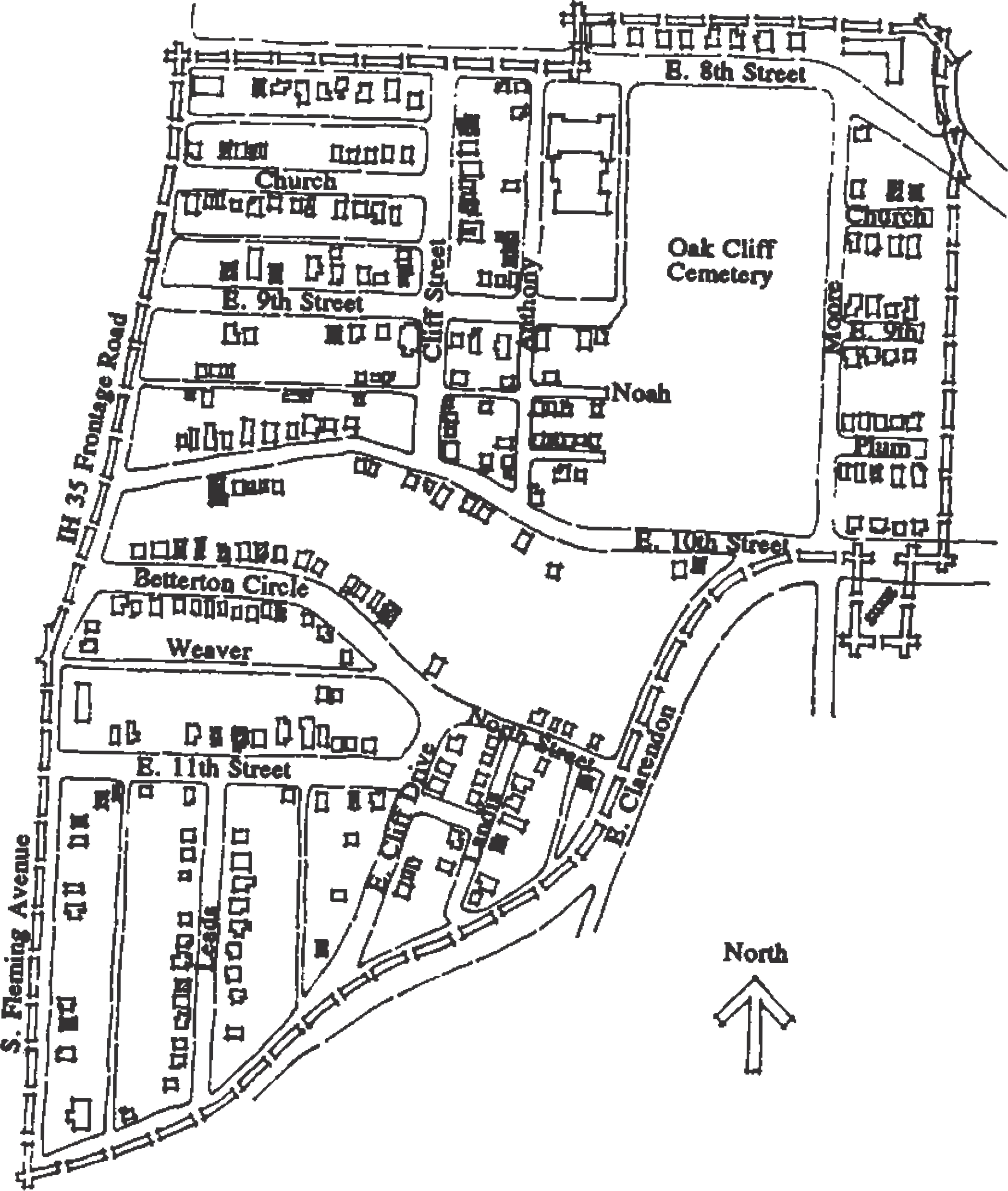
A diagram of the area designated by the city of Dallas as a landmark district in 1993.
Dallas City Hall
Situated on the northeastern edge of Oak Cliff, the neighborhood is made up of a variety of types of homes, from shotguns to two-story vernacular Queen Anne-style houses. It encompasses about 15 blocks and rests on hilly terrain overlooking downtown Dallas and the Trinity River. Some lots sit empty. Others hold houses that look like they’re falling apart or in the process of getting fixed up. Interstate 35E, E. Eighth Street, the former interurban right of way and Clarendon Drive make up the rough boundaries of the area designated by the city of Dallas as the Tenth Street Historic District.
A document on the city’s website, “Tenth Street Historic District: A Historic African-American Neighborhood in Dallas, Texas,” explains the history of the neighborhood. The document, a collaboration between the city of Dallas and the Texas Historical Commission, says the historical district is part of an area once called Hord’s Ridge after Tennessee native and slave owner William H. Hord, who settled there in 1845. Hord’s and others’ slaves were not told of their freedom until June 19, 1865, two years after the Emancipation Proclamation was issued.
The freedmen and women stayed at Hord’s Ridge, eventually being deeded 10 acres of land between 1865 and 1867, according to the city document. Other freedmen and women migrated to the area, looking for employment and a community.
According to the city, T.L. Marsalis, a grocer, landowner and president of Dallas Land and Loan Co., purchased what remained of the Hord family land beginning in 1887 and replatted the area as the “Tenth Street Addition,” creating a subdivision that resembles the neighborhood’s current size and configuration.
Then, in 1904, W.J. Betterton platted “Betterton Circle” and developed the remaining vacant land into residential lots. The neighborhood continued to grow, as did other freedmen’s towns.
Eventually, Tenth Street had a school, two churches and enterprises such as a bottling plant, banks and pharmacies. It was a flourishing community until the Great Depression. Tenth Street and other freedmen’s towns in Texas and Oklahoma then began seeing a steady decline, according to the city. During the 1940s and ’50s, residents started to leave Tenth Street, primarily for California, in search of work.
Even as Tenth Street continued to deteriorate, it was nominated to the National Register of Historic Places in 1994, a year after the community was officially designated as a Dallas Landmark District.
Clarence Glover, a local historian and former Southern Methodist University history professor, said that as African-Americans came out of slavery, they set up communities like Tenth Street all across the country in both rural and urban areas, and those places began to thrive. But as cities grew, these communities began to fall apart. “It swallowed up these freedman towns,” he said. “They became gentrified over a period of time, like we’re seeing in Tenth Street.”
Today, many freedmen’s towns face their own issues. Dallas’ Elm Thicket-Northpark, for example, has faced undesired development and rises in property values that could push out legacy residents. Joppa, in southeast Oak Cliff, has been plagued by pollution and lacks needed infrastructure. Both neighborhoods are threatened by gentrification.
Other than 15 years spent in California, 79-year-old Patricia Cox has lived in Tenth Street her whole life. When she was growing up, the neighborhood was exciting, she said. Even though all the streets in the neighborhood were initially made of gravel, it was developed enough to have its own gas stations, a movie theater and grocery stores.
“Everything was just big to us,” she said. She recalled going on Jefferson Boulevard to shop and said it was like going downtown. “We thought we always had our own downtown Dallas in Oak Cliff,” she said. “We just grew with the city. As it grew, we grew.”
Eventually though, things started to change. Once I-35 was constructed in 1959, it cut the neighborhood off from Oak Cliff and all the main shops and stores that Cox remembered going to, she said. “They all disappeared,” she said. “Everything went to the other side of the freeway. … So, our money always had to go out of our neighborhood.”
She said of the freeway, “It was an inconvenience for us, but it was OK for getting downtown quickly.”
Today, she describes Tenth Street as a dead end. “It’s not a neighborhood anymore,” she said. When her great grandchildren come over, there’s nowhere for them to play and nothing to do. She doesn’t have a car to take them anywhere.
“In other words, I don’t get to play in my own backyard, and that’s not a good thing,” she said. “I’m very worried and concerned about the survival of Tenth Street.”
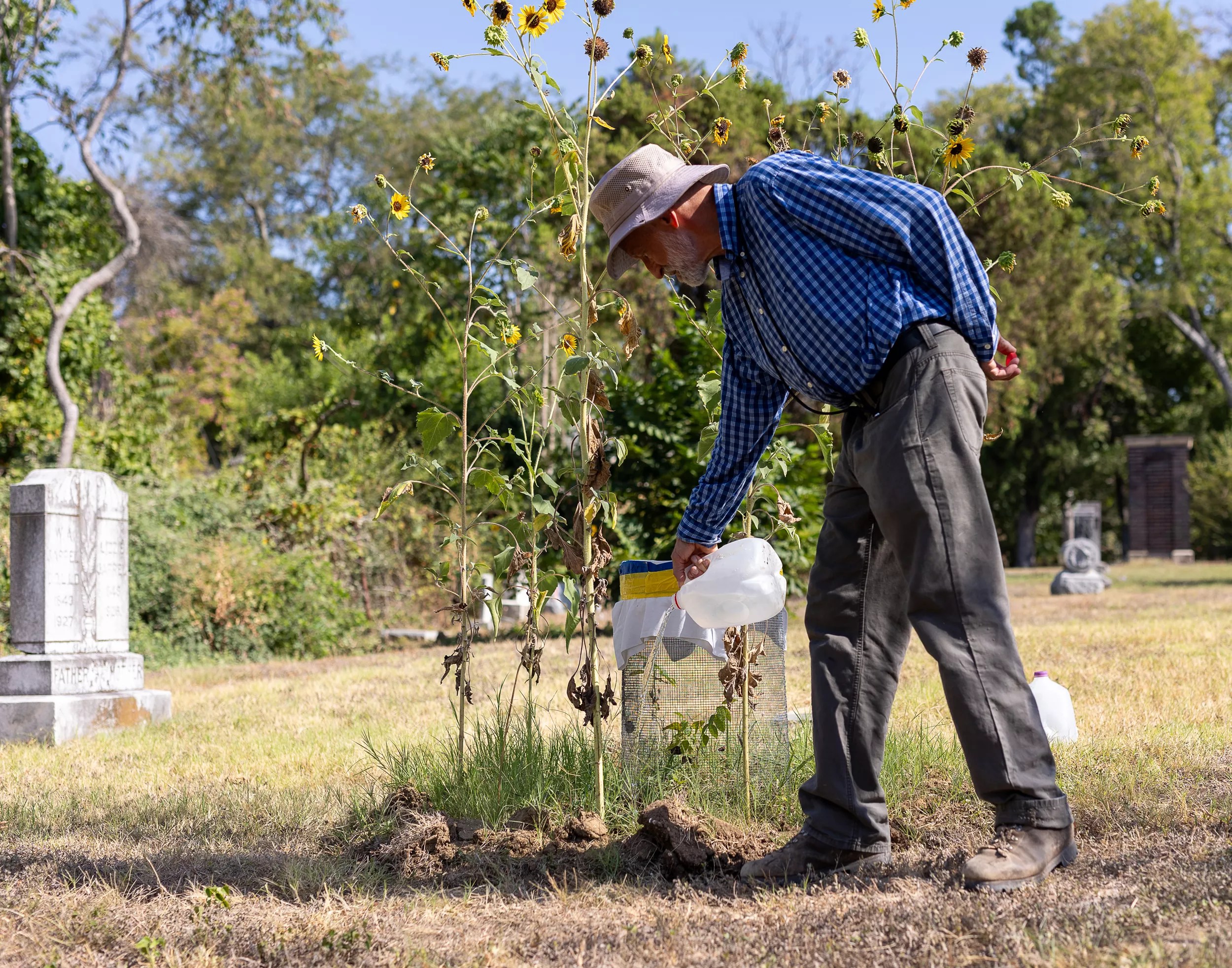
Landmark Commissioner Robert Swann waters plants in the Oak Cliff Cemetery.
Nathan Hunsinger
Cox thinks it will ultimately take investment in the neighborhood to save it. “In order for us to have something, the city would have to put some of those tax dollars that we do spend back into our neighborhood, but they don’t see any reason to invest in our neighborhood, except for the deck park and destroying what’s here to do so. They want to build a whole new neighborhood, and we would like to keep our neighborhood.”
Tenth Street is like a diamond in the rough to Cox. “It just needs to be taken care of and rebuilt instead of being ignored and neglected,” she said.
These days, homes are falling apart in Tenth Street. Others have caught fire and had to be torn down. Demolitions have also played a role in Tenth Street’s destruction.
A 2010 city ordinance that allowed for the quick demolition of structures smaller than 3,000 square feet has led to much of the destruction of the neighborhood. Between the time the district was formed and 2017, the city demolished 72 of the district’s 260 homes. Often, these homes were demolished because they were determined to be urban nuisances, creating blight. Many of the lots they sat on are still empty.
In 2019, Legal Aid of Northwest Texas and the Tenth Street Residential Association sued the city, claiming it was demolishing homes in the neighborhood at a disproportionate rate. Residents were calling for the ordinance to be abolished.
Carolyn King Arnold, the City Council member for the district, secured a five signature memo with help from others on the council to temporarily halt the use of public funds for any demolitions in Tenth Street. Although the ordinance has largely gone unused since, it still hangs over the community.
Page Jones, a spokesperson for the city, said the ordinance is still on the books, but Dallas is working toward a proposed zoning code amendment to address the issue.
At a press conference in March, residents said the city has home repair programs that could help preserve the neighborhood, but the requirements limit access for Tenth Street residents. For example, deeds and titles are required for Dallas’ home improvement and preservation program and for the senior home repair program.
“Everybody doesn’t have a clear deed to their homes over here, but they’ve been in the homes for over 20 years,” Cox, president of the Tenth Street Residential Association, said at the press conference. “That should count for something.”
The city has a program that helps residents rectify a variety of title and property issues. In 2020, The Title and Property Assistance program was launched on a pilot basis to provide legal aid to residents to help determine and document ownership of their homes.
On top of all the demolitions, Johnson said, the area has historically lacked the kind of investment needed to stay afloat.
“They became gentrified over a period of time, like we’re seeing in Tenth Street.” – Clarence Glover, local historian
Johnson said Tenth Street is the way it is today due in large part to redlining, a discriminatory practice in which banks refuse to make loans to purchase or repair homes in minority neighborhoods. For example, the home he eventually bought in Tenth Street has roof and foundation damage. The family that formerly lived there told him that a post oak tree fell on the roof of the house and damaged the foundation. He asked why it was never repaired and was told the family never had the money to do so. “They went to apply for the loans, and the banks wouldn’t lend,” he said.
Promises of more funding had been made in the past, but they’ve never come to fruition, Johnson said. It’s made the community suspicious of people who say they want to come and help, he said.
There are a few steps being taken to preserve the neighborhood, he said. Arguably one of the most significant is the attempt to rebuild the Sunshine Elizabeth Chapel.
According to the city’s website, the church was constructed at 1026 E. 10th St. in 1889. It was torn down and reconstructed in 1910. As the community began to grow, the chapel became a focal point and meeting place. The roof of the church collapsed during a storm in 1995, and the structure was demolished in 1996 “after vacancy in the neighborhood led to decreased church attendance and eventual disrepair,” according to the city.
“That church was, at one time, the hub of the community,” Johnson said. With the help of Rayo Planning, he submitted an application for a $1 million grant. The application has advanced to the second stage of the grant process, Johnson said. That money could go toward reconstructing and rehabilitating structures in the neighborhood, such as the church.
He and others are also preparing to clean up the neighborhood’s Oak Cliff Cemetery, including the removal of invasive plants.
One person who spends a lot of time in the cemetery is Robert Swann. Tenth Street is likely the only freedmen’s town with an intact slave burial ground, Swann said.
Swann is the landmark commissioner for Dallas’ District 4, which includes Tenth Street. He can often be found in the cemetery researching burials and trying to manage the plants. Among his goals are a complete inventory of native plants that have been identified there and creation of a management plan to ensure the survival of the most appropriate trees, shrubs and grasses in the cemetery and to document unmarked burials there.
He became interested in Tenth Street after seeing Elizabeth Chapel in the ’90s. The church and its steeples stood tall above the neighborhood, allowing Swann and others to see it from a distance as they drove on the freeway. “I thought for a long time, ‘That’s a place I need to get on the ground and walk.'”
Before he got a chance, Elizabeth Chapel was demolished.
In July 2008, he took a train to a station in Oak Cliff looking for Tenth Street. He didn’t know exactly where it was, but he knew it was in the direction of I-35 from there, so he started walking that way. That day, he found Tenth Street and a vacant house in the neighborhood that he wanted to buy. Swann said sometimes the owners of the homes in Tenth Street would die without having written a will. This can complicate obtaining the deeds and titles of homes because potential buyers need to track down all of the homeowner’s heirs. Swann said he worked for the next seven and a half years tracking down all the heirs of the owner of the home he wanted to buy.
As he worked to purchase the house, he started attending meetings about Tenth Street and advocating for its preservation. He said City Council member Arnold saw him at a few of these meetings and eventually asked him to be her landmark commissioner. He initially told her he wasn’t sure he was qualified because he didn’t know what the Landmark Commission was. Arnold assured him he was qualified, and he had his first meeting as a commissioner in February 2017.
These days, Swann attends landmark commission meetings once a month and spends a lot of time researching Tenth Street and working in the Oak Cliff Cemetery. He also does extensive research into the district and says the city’s account of how the neighborhood was created isn’t exactly right.
The city’s origin story for Tenth Street implies that it started with the 10 acres that was deeded to freedmen by William Henry Hord and that subsequently T.L. Marsalis platted the Tenth Street Addition beyond the 10 acres that Hord had already deeded. But Swann said his research indicates the neighborhood started with the purchase of lots by a man named Anthony Boswell in 1888.
In October 1887, William Brown Miller sold four acres at the foot of what was then known as the Beatty Cemetery to William J. Betterton. In late October 1887, Betterton subdivided these four acres into 18 lots.
In 1888, Anthony Boswell, a Black man who came to Dallas from Talladega, Alabama, bought three of the 18 lots, Swann said. The same day, Hillary Andrew Boswell purchased two more of the 18 lots. In the next year or two, Anthony Boswell bought two additional lots. Within the next three years, Anthony Boswell established a church (the Elizabeth Chapel), a store, his residence, and a school.
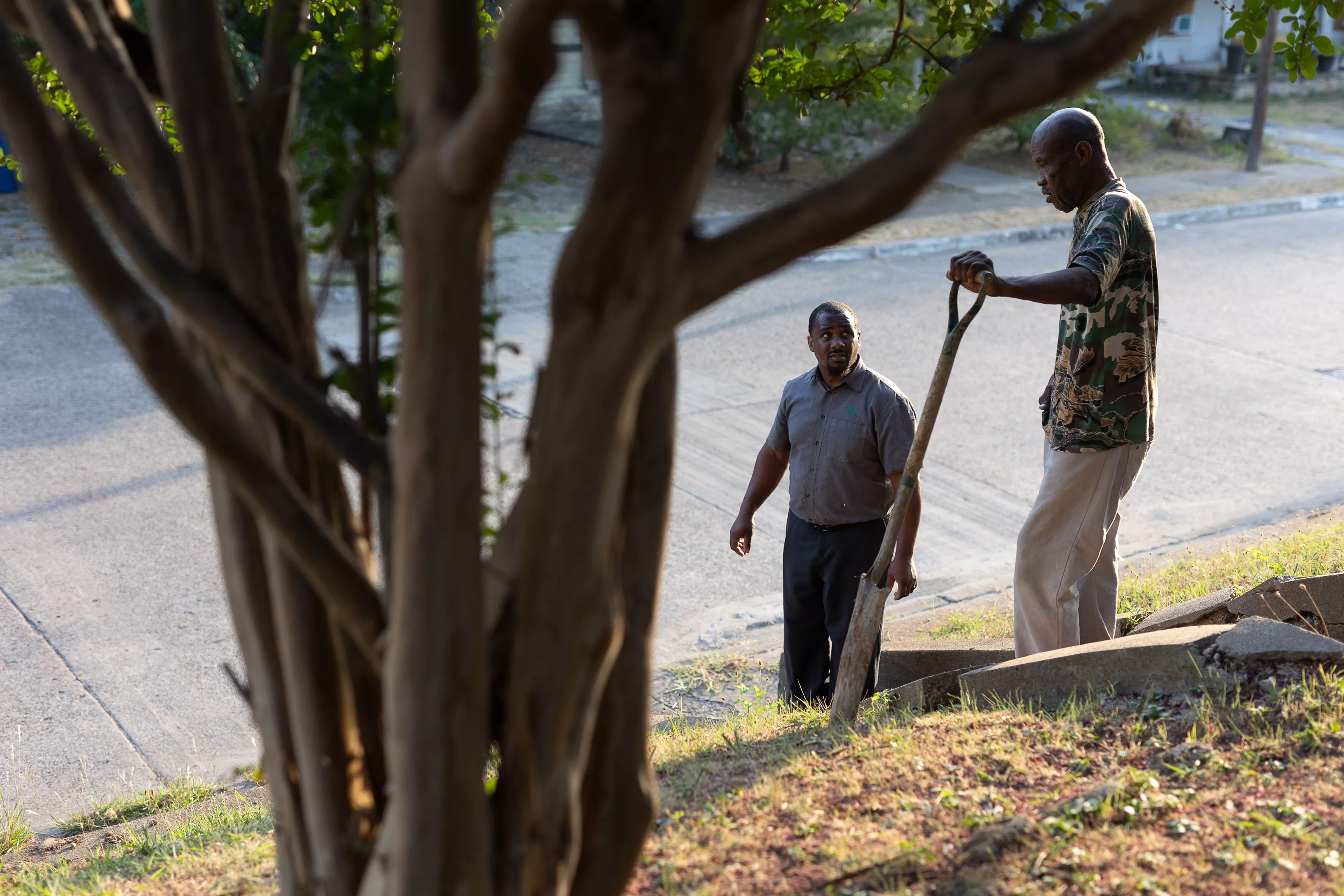
Larry Johnson talks with his neighbor Benny Harris, who was born in the Tenth Street neighborhood.
Nathan Hunsinger
What was then called Original Oak Cliff was platted in 1887. In 1890, Marsalis decided to subdivide block 101 of Original Oak Cliff. This is the action that some people refer to as the Tenth Street Addition, but that name doesn’t appear in any primary record, according to Swann.
The panic of 1893 opened up properties to Black residents to the west along Tenth Street. They began buying properties farther west, which started to expand the community to its full size, which was realized before the end of World War II.
He said the city’s version of the creation of Tenth Street robs freedmen and women and their descendants of their historical significance to the area. As Swann and architect Joanna Hampton wrote in an article for American Institute of Architects Dallas, false origin stories about the neighborhood “perpetuate a view that Tenth Street is not worth the effort of preservation and study.”
Monica Boswell Mitchell, the great-granddaughter of Anthony Boswell, said she remembers hearing about Tenth Street as a child, but it wasn’t until she was an adult that she visited the neighborhood. She said it was an emotional experience seeing the fruits of her great-grandfather’s labor. She said seeing how the neighborhood has deteriorated over the years troubled her.
“It did not seem as if the city was very interested in maintaining this remarkable history that is part of the American story,” she said. “That actually saddened me.”
Despite this, she’s still optimistic for the future of the neighborhood. “We always have to be optimistic,” she said. “If he [Anthony Boswell] had optimism to move from Talladega, Alabama, to Texas to start a new community in the face of Jim Crow, then there’s always optimism.”
Swann said that for Tenth Street to ever be Tenth Street again, Elizabeth Chapel will have to be brought back. But he thinks it will take even more restoration to ultimately save the neighborhood. “I think that it’s going to take something very bold and comprehensive in terms of the restoration and reconstruction of Tenth Street to save it because there’s too much going on around Tenth Street that is big vision,” he said.
He cited the deck park called the Southern Gateway that’s in the works on top of I-35, immediately to the southwest, the advancement of the Bishop Arts District from the west and the yearly rise in property values.
“If Tenth Street is just a troubled neighborhood that’s limping along, eventually it’s going to get swallowed up by those other endeavors,” he said.
Johnson and Swann share a vision for Tenth Street. They’d like it to be restored to the level of something like Colonial Williamsburg, known as the largest U.S. history museum. The place was the thriving capital of Virginia when the idea of American freedom and independence was taking shape, according to colonialwilliamsburg.org. It was where Virginia’s leaders proposed American independence for all 13 colonies. In 1926, the Rev. Dr. W.A.R. Goodwin, rector for Bruton Parish Church, and John D. Rockefeller Jr. teamed up to restore the town to its 18th-century appearance.
“It did not seem as if the city was very interested in maintaining this remarkable history that is part of the American story.” – Monica Boswell Mitchell, Anthony Boswell’s great-granddaughter
Swann attended the College of William and Mary, which is in the restored colonial town of Williamsburg.
As a student at the college, he couldn’t ignore the faithful restoration that permitted people to be immersed in history, but he didn’t realize the full value of the restoration at the time.
The college hosted an event for alumni over a certain age, and the oldest one to return in 1982 was part of Swann’s fraternity, for which Swann served as historian. Swann recorded an interview with the alumnus, who would have graduated in 1912. He told Swann what Williamsburg was like before the restoration.
He said it was a town of no real character, with dilapidated houses – certainly nothing like the pristine restored town it is now. Some structures had to be torn down or reconstructed to match the restoration. “There were daunting challenges,” Swann said.
He didn’t think much about all of that when he was in college. The years since and his time in Tenth Street have put it all into perspective.
“I started realizing that this African-American freedman’s town that I was trying to document had a lot in common with Colonial Williamsburg in the pre-restoration days,” Swann said.
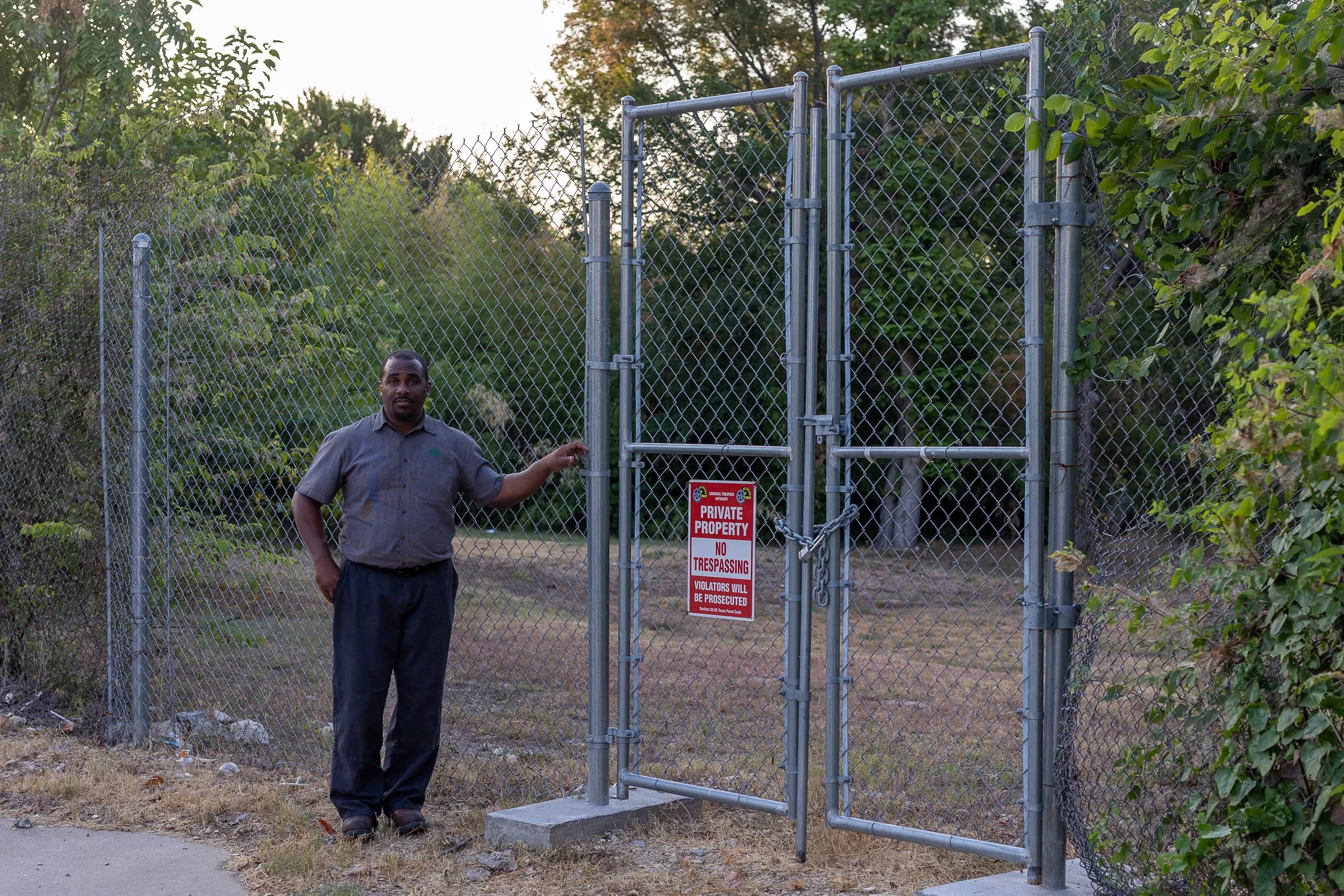
Larry Johnson at the site of the Elizabeth Chapel.
Nathan Hunsinger
One advantage Tenth Street has is that it’s been threatened by “inappropriate development” only in the last six or seven years, Swann said. This is development that Swann said doesn’t match the character and historic period of the neighborhood. “So, we do not face the challenge of too much inappropriate development. But it’s coming, and it’s coming fast,” he said.
“I came to see that what Colonial Williamsburg is to telling the story of American independence, the Tenth Street freedman’s town could be to telling the story of African-American independence because it’s all here,” Swann said. “Now, does it have associations as famous as George Washington and Thomas Jefferson and some of the other people that walked the streets of Williamsburg? No, not really. Does it need to?
“The story of African-American independence was not about a few great men who led the revolution or wrote the initial founding documents. It was a story about a great community that was doing this in settlements like Tenth Street everywhere – building wealth, educating children to enter professions, establishing schools so they could create the first literate generation out of slavery. So, I think that the parallel is perfect. Great men and women did walk these streets.”
Even though he’s not sure how realistic it is, Johnson said the goal is to have an African-American Williamsburg right here in Dallas.
“I don’t know if Tenth Street will get to that level of preservation, but that’s what we’re striving for.”
He said the U.S. doesn’t have a properly restored freedmen’s town, and he wants Tenth Street to be one of the first. “The United States only has fractions and fragments of freedman’s towns,” he said. “It’s about time that we had a freedman’s town to tell the history of these freedmen.”